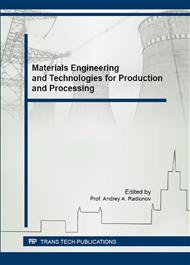[1]
D. Wu, Z. Li, Study on the machinability of free cutting non-lead austenitic stainless steels, Advanced Materials Research. 430-432 (2012) 306-309.
DOI: 10.4028/www.scientific.net/amr.430-432.306
Google Scholar
[2]
G.C. Jiang, K.L. Huang, Y.Q. Zhuang, Bismuth free-cutting stainless steel 410, Bull. Bismuth Inst. 56 (1989) 7-9.
Google Scholar
[3]
V. Finger, Enfwicklung und Industrieer pobung des Uhrentriebstahls 100 SBi7, Fertigung – stechn. und Betr. 6 (1988) 358-360.
Google Scholar
[4]
M.O. Holowaty, D. Bhattacharya, US. Patent 4, 244, 737. (1981).
Google Scholar
[5]
A.V. Ryabov, I.V. Chumanov, Study and Possibility of making new easy to cut corrosion-resistant steel, Russ. Metall. (Metall. ). 12 (2012) 1065-1067.
DOI: 10.1134/s0036029512120117
Google Scholar
[6]
K. Watari, Y. Okada, US. Patent 5, 922, 145. (1999).
Google Scholar
[7]
M.O. Holowaty, I.F. Hughes, J. Lude, US. Patent 4, 389, 249. (1983).
Google Scholar
[8]
A.V. Ryabov, A.M. Panfilov, N.S. Semenova, The X-Ray–TV Investigation of Behaviour of a Bismuth Sample Introduced to Molten Steel, Modern Applied Science. 9 (2015) 252-259.
DOI: 10.5539/mas.v9n2p244
Google Scholar
[9]
H.M. Pielet, D. Bhattacharya, US. Patent 4, 736, 790. (1988).
Google Scholar
[10]
D.N. Hawkins, The machinability of steel, Steel Times. 12 (1989) 688-689.
Google Scholar
[11]
H.T. Liu, W.Q. Chen, Hot ductility of eco-friendly low carbon resulphurised free cutting steel with bismuth, Ironmaking and Steelmaking. 1 (2014) 19-25.
DOI: 10.1179/1743281212y.0000000095
Google Scholar
[12]
S. Naghdy, A. Akbarzadeh, Characterization of dynamic recrystallization parameters for a low carbon resulfurized free-cutting steel, Materials and Design. 53 (2014) 910-914.
DOI: 10.1016/j.matdes.2013.07.031
Google Scholar
[13]
S. Afshan, D. Balint, D. Farrugia, J. Lin, A new experimental method for identifying the conditions necessary for diffusion bonding in free cutting steels, Materials Science and Engineering A. 586 (2013) 25-30.
DOI: 10.1016/j.msea.2013.07.056
Google Scholar
[14]
T.J. Zhang, Effective, controlled method to add sulfur into molten steel to produce free cutting steel for automobile, Applied Mechanics and Materials. 364 (2013) 558-562.
DOI: 10.4028/www.scientific.net/amm.364.558
Google Scholar
[15]
J.P. Han, Y. Li, Z.H. Jiang, Y.C. Yang, X.X. Wang, L. Wang, K.T. Li, Summary of the function of Sn in iron and steel, Advanced Materials Research. 773 (2013) 406-411.
DOI: 10.4028/www.scientific.net/amr.773.406
Google Scholar
[16]
A.V. Ryabov, O.K. Tokovoi and I.V. Chumanov, RU. Patent 2, 561, 558. (2015).
Google Scholar
[17]
Z. Li, D. Wu, W. Lv, Z. Zheng, S.P. Kang, Investigations on low environmental impact machining processes of free cutting austenitic stainless steels, Applied Mechanics and Materials. 377 (2013) 112-116.
DOI: 10.4028/www.scientific.net/amm.377.112
Google Scholar
[18]
H. Kikuchi, H. Hamashima, O. Murata, T. Ihara, An omission mechanism of built-up edge based on damage mechanics model in Low Carbon Steel, Seimitsu Kogaku Kaishi/Journal of the Japan Society for Precision Engineering. 10 (2013) 955-958.
DOI: 10.2493/jjspe.79.955
Google Scholar
[19]
J. -L. Li, Z. Li, H. Chen, X. -P. Su, H. Tu, J. -H. Wang, Fabrication of low bismuth content Bi-Mn-Fe alloy used for free-cutting steel, Fenmo Yejin Cailiao Kexue yu Gongcheng/Materials Science and Engineering of Powder Metallurgy. 5 (2013).
Google Scholar
[20]
H. Sakai, Y. Osawa, H. Yoshida, Japan. Patent 03215372. (1991).
Google Scholar


